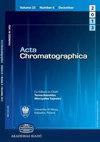Estimation of pitavastatin and ezetimibe using UPLC by a combined approach of analytical quality by design with green analytical technique
IF 1.7
4区 化学
Q3 CHEMISTRY, ANALYTICAL
引用次数: 9
Abstract
The current study explores a design and development of the simple, fast, green and selective novel method of UPLC to quantify pitavastatin and ezetimibe simultaneously. The combined approach of Green Analytical Method with Quality by Design-based risk assessment was done using the Ishikawa fishbone diagram followed by a rotatable central composite design used for the optimization. The optimal chromatographic separation was attained through a mobile phase of 72: 28% v/v ethanol and 0.1% orthophosphoric acid (pH 3.5), with a 0.31 mL min−1 flow rate. The developed UPLC-PDA method was sensitive and specific for pitavastatin and ezetimibe, with linearity ranging from 2 to 30, 10–150 μg mL−1 with an R2 of 0.9999 and 0.9997, respectively. The forced degradation study of stability-indicating assay results shows the degradation in respective stress conditions. The developed UPLC method was validated and found to have sensible results with good linearity, accuracy and precision. Further, the greenness was evaluated using five states of art metrics like NEMI, GAPI, AES, AMGS, and AGREE metrics and found the greenest results. Based on the results we concluded that the developed UPLC method could be efficient for the simultaneous determination of pitavastatin and ezetimibe in bulk and tablet dosage.UPLC法结合设计分析质量和绿色分析技术评估匹伐他汀和依折麦布
本研究探索了一种简单、快速、绿色和选择性的UPLC新方法的设计和开发,该方法可同时定量匹伐他汀和依折麦布。绿色分析方法与基于设计质量的风险评估相结合的方法是使用Ishikawa鱼骨图进行的,然后是用于优化的可旋转中心复合材料设计。最佳色谱分离是通过72∶28%v/v乙醇和0.1%正磷酸(pH 3.5)的流动相实现的 mL最小−1流速。所开发的UPLC-PDA方法对匹伐他汀和依折麦布敏感且特异,线性范围为2至30,10–150 μg mL−1,R2分别为0.9999和0.9997。稳定性指示测定结果的强制降解研究显示了在各自的应力条件下的降解。对所开发的UPLC方法进行了验证,发现该方法具有良好的线性、准确度和精密度,结果合理。此外,使用五种最先进的指标,如NEMI、GAPI、AES、AMGS和AGREE指标,对绿色度进行了评估,并发现了最绿色的结果。基于这些结果,我们得出结论,所开发的UPLC方法可以有效地同时测定本体和片剂中的匹伐他汀和依折麦布。
本文章由计算机程序翻译,如有差异,请以英文原文为准。
求助全文
约1分钟内获得全文
求助全文
来源期刊

Acta Chromatographica
化学-分析化学
CiteScore
4.00
自引率
0.00%
发文量
55
审稿时长
2.3 months
期刊介绍:
Acta Chromatographica
Open Access
Acta Chromatographica publishes peer-reviewed scientific articles on every field of chromatography, including theory of chromatography; progress in synthesis and characterization of new stationary phases; chromatography of organic, inorganic and complex compounds; enantioseparation and chromatography of chiral compounds; applications of chromatography in biology, pharmacy, medicine, and food analysis; environmental applications of chromatography; analytical and physico-chemical aspects of sample preparation for chromatography; hyphenated and combined techniques; chemometrics and its applications in separation science.
 求助内容:
求助内容: 应助结果提醒方式:
应助结果提醒方式:


